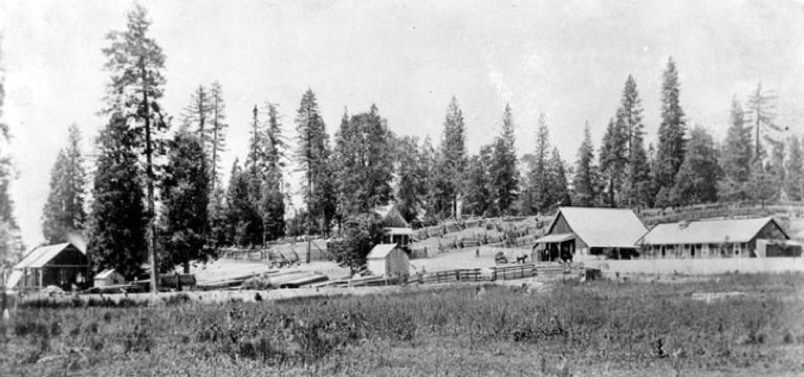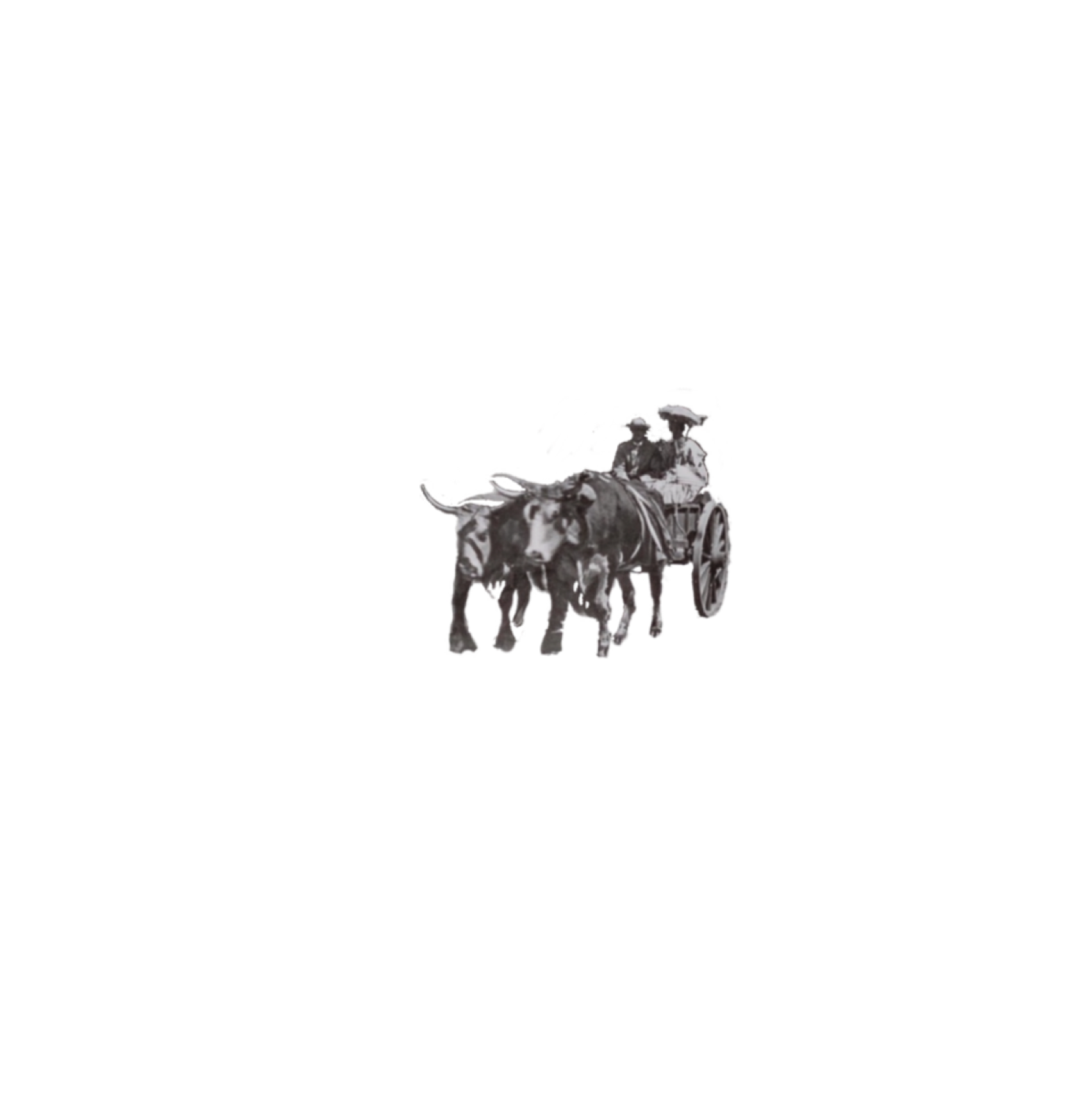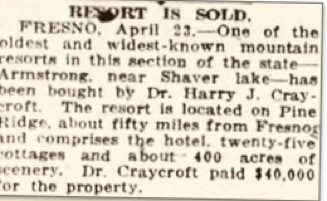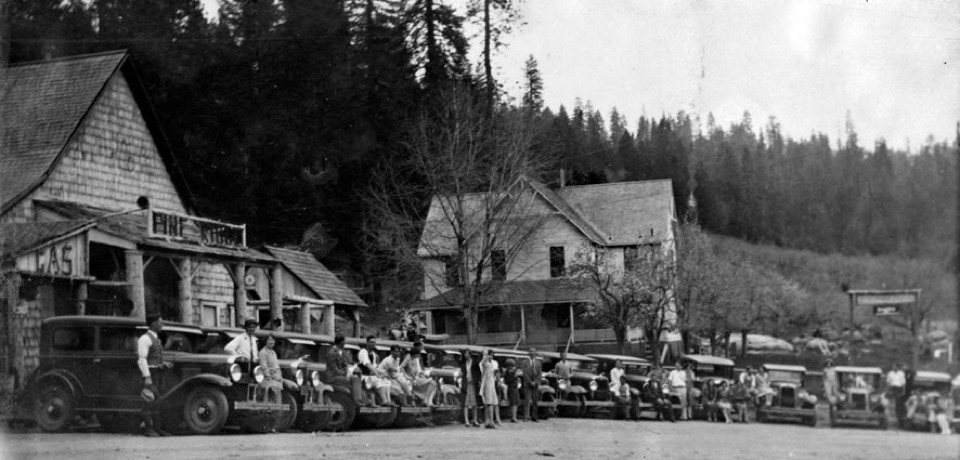

The Shaver Ranch: The Early Years


by John Shaver Craycroft, October 2021
the edge of the road, moving charred branches and debris, there is the brass benchmark embedded in the stone: 4,940 feet above sea level.
Yes, this is the place.
This rock by the side of the road, here for thousands of years, before man, and then for all the comings and goings through the years. If rocks could talk!
The idyllic meadow, formerly surrounded by pines and cedars, has long been a natural way-stop and gathering place. Geologically, it is a small hanging valley set between the crest of Pine Ridge and the San Joaquin Canyon. A few hundred yards below the meadow, Jose creek plunges 3,000 feet down the steep mountainside to the San Joaquin River. This narrow shelf in the mountainside is the only practical way to get from the foothills to the high mountain basins of Shaver and Huntington Lakes. The trail of the indigenous Mono Tribe likely went through here, and the makers of the original wagon road followed this route.
.
Lena Shaver, a Legacy of Determination, Love, Loss, and Renewal
The Shaver Ranch on Pine Ridge has been in the care of the Shaver family for 100 years. And one year since the Creek Fire left it in ashes.
It is difficult to recognize. But there is the familiar curve of the road, the old rock wall, and the metal Shaver Ranch sign. On the granite rock at

August 1966--Charles Burr Craycroft, son of Grace and Harry Craycroft, on his final trip to the Shaver Ranch pointed out the rock with benchmark across the road. Then resting on it for a while, he talked about the importance of this place to the family, of growing up here, and recounted some of "Grandma Shaver's" memories of the early days on Pine Ridge.

1893



1966

July 4th, 1893—As the oxen labored, slowly but surely, hauling the wagon up the hot and dusty Toll House Grade, Lena Shaver finally got a chance to see what her husband had been talking about so passionately for the last two years. This first portion of the trip may not have met her expectations as it was a steep, rough, rocky, dusty wagon trail. But when they reached the meadow at Jose Creek, it changed dramatically. They certainly would have stopped here to rest and water the animals as it was the first opportunity, an oasis, after the long haul up the grade.
At that time, the Kenyon family operated the Post Office, a store and blacksmith shop with cabins for guests, an apple orchard, and cultivated fields in the meadow. The following year they would add a school. This was the center of the community of Pine Ridge. Little did she know that one day, this would become her beloved mountain home.




Kenyons Store 1891
She and her young daughters, Grace, and Ethel were on the last leg of their cross-country journey to join her husband, CB (Charles Burr) Shaver. He had spent most of the previous year supervising the flume and dam's construction on Stephenson Creek, while his partner LP Swift was in charge of setting up the lumber mill.
After Kenyon’s, the wagon trail passed Ockenden’s and then Musick’s Mill before getting to the hill, now known as “The Point” where the meadows of Stephenson Creek came into view. Down to the right around the hill were the dam and millpond. She found CB with a crew working on repairing the dam after a washout in the spring



1897

The Massive mill building was under construction, the timber frame walls waiting for their skin of pine boards. On the hillside above, scattered among the trees were wood frame buildings, a store, and cabins, one of these was their new home. The scene was likely reminiscent of her childhood growing up on a small farm in the Pennsylvania woods. She was born in the small village called Cedar Run.








Though she is not mentioned a great deal in the history books, Lena was a remarkable woman who played an essential role in developing the Fresno Flume and Irrigation Co. and the Pine Ridge/Shaver Lake community. For over four decades, she was a prominent and respected figure in the mountains and Fresno. She was strong and forthright, with a good business sense, she was a close confidant and advisor to her husband. Her pragmatic nature balanced his idealism. The development of the company was a group effort, accomplished principally by the actions of four families: the Musicks, Shavers, Swifts, and the Longs. The Musick brothers were among the first to conceive of a flume to transport lumber and irrigation water to the valley and brought considerable acreage and a lumber mill to the endeavor. CB Shaver and the Swift brothers contributed some capital, but their most important contributions were their expertise, energy, and ability to lead. And the Longs, father, and son provided their management experience and the money to get the project off the ground.

CB's brother Truman came from Michigan and worked for many years for the company, first as a woodsman and then in the box factory at Clovis. Truman was part of the other essential element--a dedicated workforce. Together, management and workers met many challenges and setbacks. CB, generally the spokesman, said they would complete the flume within two years, and it was. The dam failed. CB said they would rebuild it within months, and it was--taller and more robust. The mill at Clovis burned to the ground. CB said they would rebuild it within a year, and was. There was an economic panic, and the company continued to produce lumber and grew through the difficulties. Unlike most Sierra lumber camps, it evolved into the vibrant and enduring community of Shaver Lake.
Truman
Shaver
The Shavers split their time between the mountains, which they preferred, and Fresno, where Lena practiced the intricacies of Victorian etiquette so they could properly entertain business associates and financial backers in the expected fashion of the day. At Shaver, the social life was more relaxed, with the crew, surveyors, engineers, and forest rangers often meeting on the cabin's porch or around a campfire. For pleasure, they would swim or take boats on the lake or camp at Dinkey Creek. Evenings they would often walk the flume out to what they then called Sunset Rock, now known as Shaver Rock.
Around 1900, CB was diagnosed with an acute form of diabetes, and the doctors put him on a special diet and told him to stop smoking. He did but continued to sport an unlit cigar in his mouth. In 1901 the company suffered a setback, LP Swift died of a heart attack. His brother Harvey came out from Michigan to take over his role.
CB maintained his enthusiasm, he carried on with his normal active lifestyle in spite of his struggle with diabetes. He traveled frequently on business, often taking Lena or his daughters along with him. In 1906 they took a cruise to Alaska and in September of 1907 took his new White Steamer automobile on the new craze of auto touring on a trip to Los Angeles. Ultimately a relatively minor condition caught up with him later that year. With a compromised immune system due to his condition, an infection on his neck spread throughout his system and after being bedridden for three weeks, he passed away on Christmas Day, 1907.





Dr. W.T. Maupin Dr. J.L. Maupin Dr. Harry J. Craycroft
His doctors W.T and J.L. Maupin, Davidson, and the young Harry Craycroft (who had just completed medical school and would marry the Shavers daughter Grace) had employed all the latest that medical science had to offer at that time. Today, even a few decades later, improved treatment for diabetes and antibiotics would make recovery routine.
With CB's untimely death, Lena held the family together, attended to raising their daughters and righting their ship. Even though they had a comfortable life in Fresno, she had no thought of leaving her mountain life. She intended to carry on CB's vision for the success of the company and the prosperity of the Shaver/Pine Ridge community. As a majority shareholder, she became a director of the company. She worked closely with her brother-in-law Harvey Swift, who took over CB's role as president, in the management of the business through some of its most productive years until they sold out in 1912.
She kept her cabin at Shaver, dividing her time between summers at Shaver and the winter months in Fresno. Her daughters married. First Grace to Harry Craycroft in 1909, Ethel to Gus Hoover in 1914, and Doris to Harold McDonald in 1918. Lena engaged in real estate development, buying and selling properties, holding mortgages, and carrying out one of CB's dreams. She built the Shaver Building at the corner of Fulton and Merced Streets in downtown Fresno, with the ground floor leased to a hardware and auto supply store with the Sierra Hotel on the second floor.
When the Edison company planned to build a new dam and flood the town of Shaver, she partnered with her son-in-law, Dr. Harry Craycroft, to create the development of Rock Haven. The name was a play on words of the town she grew up in--Lock Haven, Pennsylvania. She was able to get the Edison Co. to dismantle her cabin piece by piece and rebuild it at Rock Haven. The grandchildren delighted when they found the board from the kitchen, where they had marked their heights as they grew, now part of the ceiling of their attic bedroom. The Craycroft's built a cabin here as well.
In 1921 they acquired the old Kenyon place, which had become Armstrong's Resort by then. It included the old store built by Gus Bearing, the stately Victorian hotel built by the Armstrongs, a dozen or so cabins, a large barn with a dance hall with a stage on the second floor.


1925



1932


1929

On Special Occasions Harry would tend the Bar
They changed the name from Armstrongs to the Pine Ridge Tavern: Cabins, Hotel, Post Office, and General Merchandise Store. Harry became the Post Master. As the former physician at the Shaver Mill, he set up one of the cabins as a mountain medical office. They moved CB's Surry (with fringe) and Harry's Pheaton Doctors Buggy into the barn. They leased out the operation of the store and hotel at first and spent most of their time in the mountains at the cabins at Rock Haven.
One evening in the fall of 1927, Lena gathered the family along with other locals on the hill to witness the intentional torching of buildings of the old mill and town of Shaver. The new dam was complete and towered over the scene. When full it would leave the old site under 100 feet of water.
Lena loved her cabin at Rock Haven, but over time, she found that she preferred spending time at Pine Ridge. Here she could be part of the comings and goings of the mountain residents and frequent visitors. And so, the old hotel became the family's mountain home. It had plenty of room for the entire family. They had many happy gatherings in the living room with the stone fireplace and bearskin rug, around the big dining table with lazy-susan, or campfire, singing or reciting poetry—often performed on the stage in the upstairs of the barn. The player piano and old Victrola for a large selection of classical and popular music. Lena's sister, Minnie Swift, widow of Harvey Swift, built a cabin above the house, and they spent many happy summers there.
It was a magical place for the whole family. There was a caretaker, but the family took part in the work around the ranch during summers or weekends. There is always plenty to do, firewood, planting, clearing dead and thinning trees, fixing fences, checking on the spring. Both CB and Lena came from generations of farming and lumbering families and understood the importance of forest management.
Lena developed a heart condition later in life. Her grandson Burr Craycroft, then in Medical School at Stanford, arranged for a young woman from Kingsburg, Adeline Nord, to be a companion for Lena during the summer in the mountains. Adeline became a close family friend and later talked about how she cherished that summer with "Mrs. Shaver,” driving her around, hearing stories, and learning about the mountains. That summer, Lena passed a torch to Adeline, who would become a mountain legend of her own. She later married Karl
Smith, and they purchased and ran the Diamond D Ranch at Blaney Meadows, above Florence Lake, now called Muir Trail Ranch. In the winters, she taught school in Auberry and returned to the ranch each summer, continuing to run the ranch with her daughter and granddaughter after Karl's passing for many years.
It was to Lena's great sorrow that she could not die at Pine Ridge. In May of 1939, she passed away at her home in Fresno. But she had established a place where the entire family including seven grandchildren, and eventually twelve great-grandchildren could gather, call home or come back to when needed.
This sense of place, this refuge—their mountain home—would help them cope with the turmoil they would soon face. As the country entered World War 2, the families sought to deal with worry and uncertainty. The men enlisted— Burr Craycroft, Dick Hoover, Bob Hoover, Gordon McDonald, Doug McDonald, Red Rude—Marian Craycroft Rude’s husband, and Clinton Olson—Ethel Hoover Olson’s husband.
During the war, a great tragedy struck the family. In the summer of 1943, while spending some time at Pine Ridge with her grandchildren, Grace suffered a heart attack while attempting to save a young boy who got into trouble while swimming in Shaver Lake.
.
After the war, the families sought to put the pieces of their lives back together, the Hoovers & Olsons in Los Angeles, the McDonalds in Pasadena, the Craycrofts in San Jose, and the Rudes moved around the world as the army shifted Red's assignments until finally settling in Seattle. When the Post Office moved to Cressman's Store, and the Shaver's ranch at Pine Ridge became The Shaver Ranch. With the cousins spread out, Doug McDonald took over the major interest in the property and made it his mountain getaway and eventually his home. Doug carried on with the traditions of careful stewardship of the land and legacy.
In 1963, the grand old house burned to the ground. Fortunately, many photos and documents had been distributed for safekeeping or copied through the years. But a collection of antiques and historical memorabilia worthy of a museum was lost. Douglas McDonald replaced it with a fine home of his own, a bit farther from the road and facing the meadow
This home is gone now as well. And not just the house, look around, the desolation. But there are a group of trees at the top of the meadow that looks to have survived and a few others here and there. It will take time. But it will grow back. The history of the community is a story of responding to difficulties and challenges by getting back to work, rebuilding what was damaged, lost, or destroyed. The Stephensons, the Musicks, the Kenyons, the Bretts, the Okendens, the Swifts, the Shavers, the Cressmans, the Hoovers, Craycrofts, the Rudes, the McDonalds among many others, all have shared a dedication to these mountains, the ecological and human communities and an ingrained belief in a strong work ethic. And there, the McDonalds have put Shaver Ranch sign back up above the gate. The first step.
Among the things, which had been removed for safe keeping from the old home in the years before it burned was a stack of old 78 records, including a 1936 hit by Fred Astaire called "Pick Yourself Up."
The lyrics of this song includes a piece of familiar family advice in the refrain for dealing with adversity and setbacks:
"Will you remember the famous men, Who had to fall to rise again?
So take a deep breath, Pick yourself up, Dust yourself off, Start all over again.
Nothing's impossible I have found For when my chin is on the ground I pick myself up, Dust myself off, Start all over again."

Pine Ridge 1886-1963

1886

1894



1916 1924

1915

1910

1932



1943



1950
Resources:
• Charles Burr Craycroft—stories told during his lifetime of events he participated in or from stories he heard from his father, Dr. Harry Craycroft, mother Grace Shaver Craycroft, and grandmother Lena Roberts Shaver.
• Documents and photos from the collection of Charles Burr Craycroft
• Historical books and newspaper articles including:
• The Story of Big Creek
• Fresno County—The Pioneer Years
• Fresno Daily Expositor
• Fresno Daily Republican